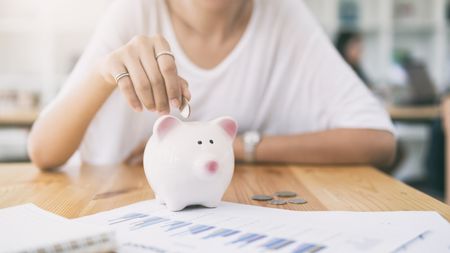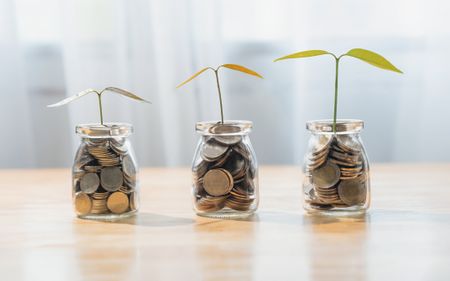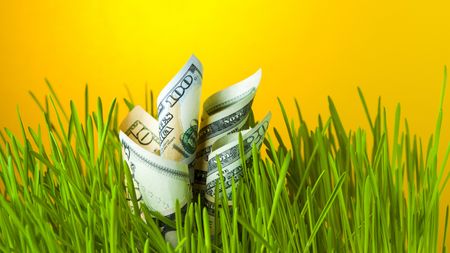What Is APY? Here's How to Score the Highest Rates
What is APY? Annual Percentage Yield, or APY, is an important factor in how much your savings could earn in a year.

What is APY? Simply put, annual percentage yield (APY) is the amount of interest earned on a savings account in one year. It takes into account compounding interest — when both your principal balance and any garnered interest earn interest. Since simple interest only pays on the principal, accounts with a high APY can help you accumulate more cash on deposits.
And the longer you keep money in an account with a high APY, the more you'll earn, which is why long-term CDs are particularly attractive right now. Currently, both high-yield savings accounts and CD accounts are offering exceptionally high APYs, in many cases over 4%.
Here's what you need to know about APY and how to score the best rates available.

Sign up for Kiplinger’s Free E-Newsletters
Profit and prosper with the best of expert advice on investing, taxes, retirement, personal finance and more - straight to your e-mail.
Profit and prosper with the best of expert advice - straight to your e-mail.
APY and compound interest
Opening an account with compound interest can be an easy way to maximize your savings. If you open a savings account with compound interest, you’ll earn interest on your savings (the principal balance) as well as on any interest you've accrued. Depending on the account, interest can be "compounded" daily, monthly, quarterly or annually.
For example, if you put $2,000 into an account that pays 1% annual interest, you’ll earn $20 in interest after a year. The next year, thanks to compound interest, you’d earn on both the principal (your initial $2,000) and on the interest. That comes out to 1% on $2,020, which would give you $2,040.
Try our savings calculator to determine how much you'll save over time.
Opening a top-earning account
APY is a key factor to consider when deciding where to deposit your savings. Both high-yield savings accounts and CDs usually offer higher APYs than traditional savings accounts, making them attractive savings vehicles for individuals looking for a fixed, predictable rate of return on their savings.
To score the highest rates possible, you'll need to compare several other factors besides APY between accounts, including minimum opening deposits and monthly fees. If you're opening a CD account, you'll need to carefully choose a maturity date that works for you financially.
Here's an example of how much you'd earn over time, depending on changes in your account's APY. If you invested $1,000 five years ago, here's what you'd have now.
APY: 4.00%
Total interest earned: $216.65
Total balance: $1,216.65
APY: 3.50%
Total interest earned: $187.69
Total balance: $1,187.69
APY: 3.00%
Total interest earned: $159.27
Total balance: $1,159.27
Use our tools below to compare rates across high-yield savings accounts and CDs.
Variable vs. fixed APY
The APY of an account can either be fixed or variable. Variable APYs fluctuate with the market and are usually associated with savings and checking accounts. On the other hand, savings rates on accounts with fixed APYs won't fluctuate. CD accounts have fixed APYs, so rates remain the same until the CD matures.
APY vs. APR
APY and APR can be thought of as opposites. APY is the rate earned on deposits if interest is compounded. APR, or annual percentage rate, is the annual cost you’ll pay to borrow money and does not take into account the compounding of interest.
APY example
You can calculate the APY on an account by using the following formula: APY = (1 + r/n)ⁿ – 1, where r= interest rate and n= the number of times the interest is compounded per year. So, if you deposited $100 for one year at 5% interest compounded quarterly, the APY would be (1 + .05/4) * 4 - 1 = .05095 = 5.095%. At the end of the year, you’d have $105.09.
Or, for an easier way to calculate how much you’ll earn, try our savings calculator.
Related Content
Get Kiplinger Today newsletter — free
Profit and prosper with the best of Kiplinger's advice on investing, taxes, retirement, personal finance and much more. Delivered daily. Enter your email in the box and click Sign Me Up.

Erin pairs personal experience with research and is passionate about sharing personal finance advice with others. Previously, she was a freelancer focusing on the credit card side of finance, but has branched out since then to cover other aspects of personal finance. Erin is well-versed in traditional media with reporting, interviewing and research, as well as using graphic design and video and audio storytelling to share with her readers.
-
 Stagflation: What It Is and Why Retirees Should Care
Stagflation: What It Is and Why Retirees Should CareStagflation — the economic bogeyman of the 1970's — may return to the US. Here's what it could mean to your retirement.
By Donna Fuscaldo Published
-
 Why Losing Your Job Could Be the Best Opportunity to Plan Your Future
Why Losing Your Job Could Be the Best Opportunity to Plan Your FutureAmid this uncertainty lies an opportunity for strategic reassessment and personal growth.
By Mario Hernandez Published
-
 5 CDs to Put Your Tax Refund Into
5 CDs to Put Your Tax Refund IntoPlanning to get a tax refund this year? Treat your future self with a risk-free way to grow your money. Here are the 5 best CDs to consider.
By Sean Jackson Published
-
 10 Best High-Yield Savings Accounts to Grow Your Tax Refund
10 Best High-Yield Savings Accounts to Grow Your Tax RefundIf you're getting a tax refund this year and want to grow it, here are the best high-yield savings accounts to make it happen.
By Sean Jackson Published
-
 3 Certificate of Deposit Accounts I Wouldn't Use Right Now
3 Certificate of Deposit Accounts I Wouldn't Use Right NowThe good news is you can earn over 4% on many CDs. However, here are three kinds of CDs I wouldn’t recommend currently.
By Sean Jackson Published
-
 Is a Long-Term CD the Best Option for Saving?
Is a Long-Term CD the Best Option for Saving?CDs offer good rates and guaranteed returns. However, are they the best option for longer range savings goals?
By Sean Jackson Published
-
 Is a Joint Bank Account Romantic or Risky?
Is a Joint Bank Account Romantic or Risky?Considering a joint bank account with your partner? Discover the advantages and potential pitfalls to determine if it's the right choice for your relationship.
By Dori Zinn Published
-
 Why a 5-Year CD is Your Best Bet After the Fed Meeting
Why a 5-Year CD is Your Best Bet After the Fed MeetingWith no rate cut at the Fed meeting in March, you still have time to lock in historically high interest rates with a 5-year CD.
By Rachael Green Last updated
-
 How to Shelter Your Tax Refund from the CPI Inflation Rate
How to Shelter Your Tax Refund from the CPI Inflation RateAre you expecting a tax refund? Here are some ways to grow it so it outpaces the CPI inflation rate.
By Sean Jackson Last updated
-
 After the Fed Meeting, Seven High-Yield Savings Accounts Worth Your While
After the Fed Meeting, Seven High-Yield Savings Accounts Worth Your WhileAt the March Fed meeting, they decided to refrain from rate cuts, giving savers more time to earn a great rate.
By Sean Jackson Last updated